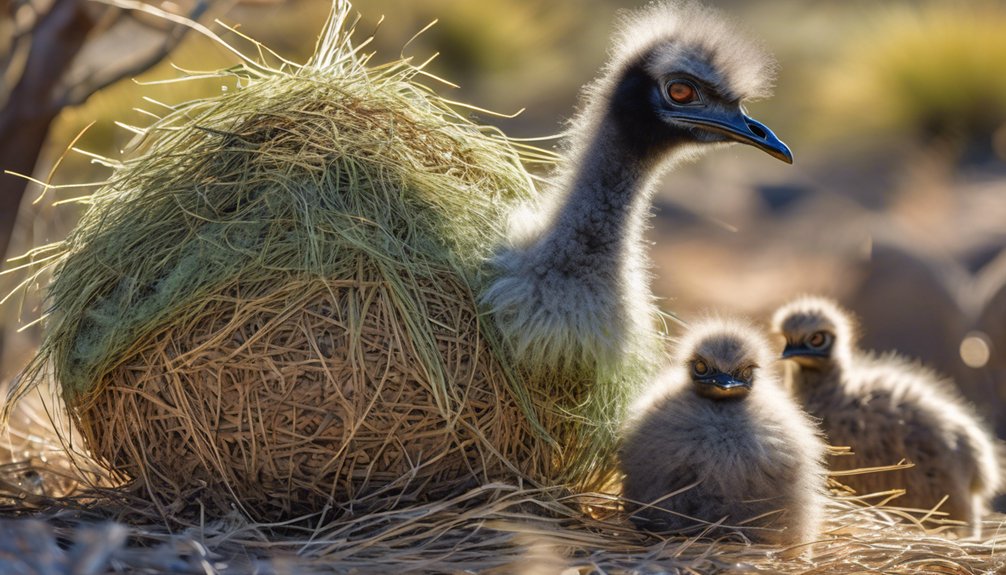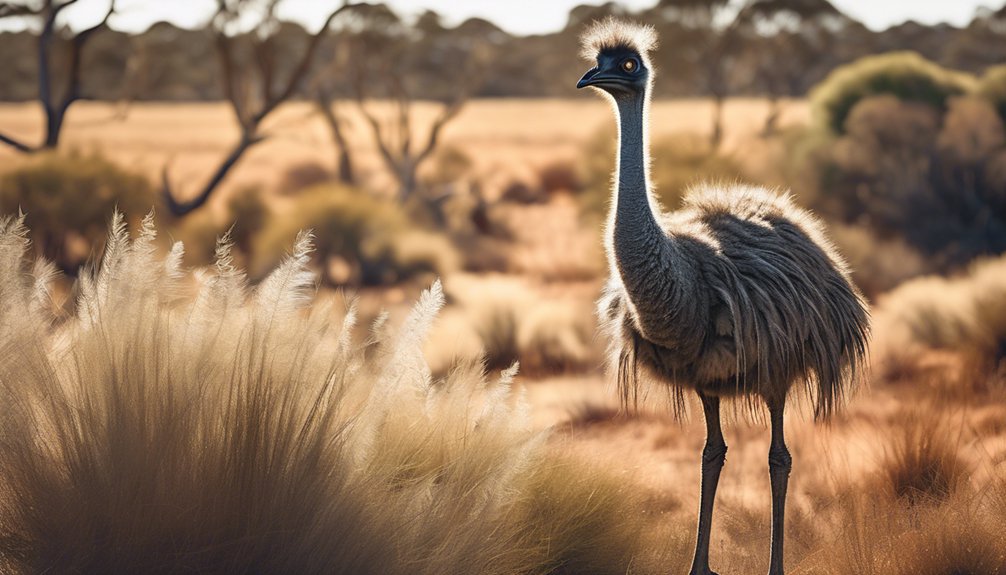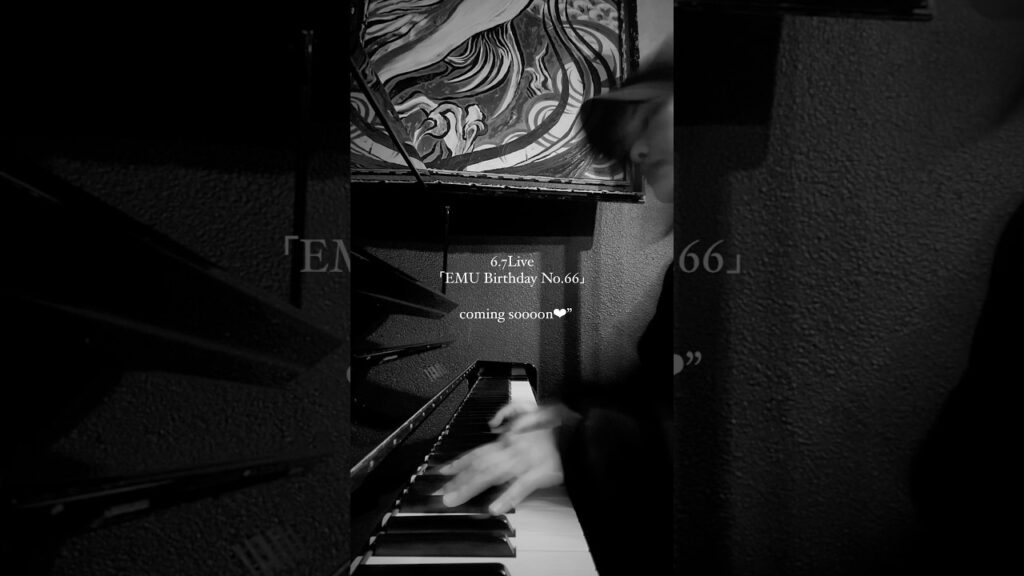
In the intricate tapestry of nature, emu reproduction stands out as a remarkable process. During the breeding season, males engage in complex courtship displays to attract females, setting the stage for their unique reproductive cycle. Once paired, the female lays a striking clutch of glossy eggs, but what happens next may surprise you. The male takes on the critical role of incubation, ensuring the eggs develop properly. This raises questions about parental investment in avian species and the survival of hatchlings.
Key Takeaways
- Emus nest in secluded areas with dense vegetation, often near water sources, to protect eggs and enhance viability.
- Female emus lay 5 to 15 glossy eggs, which are incubated by males for 50 to 60 days.
- Optimal incubation temperatures range from 97 to 99°F, with humidity affecting moisture loss from eggs.
- Hatchlings instinctively break free and seek warmth, exploring their surroundings to learn survival skills.
- Male emus invest significantly in raising young, teaching them about food sources and safety before they become independent.
The Breeding Season of Emus

When the breeding season arrives, emus engage in a fascinating ritual that begins in late summer to early autumn, typically from January to March in Australia. During this time, their breeding behaviors become prominent, as they prepare for potential mates.
Emus exhibit a remarkable adaptability, migrating seasonally to find optimal habitats rich in resources. This migration is crucial, as it aligns with the availability of food and water, supporting their reproductive needs.
As they gather in specific areas, males begin to establish territories, showcasing their physical prowess and readiness to mate. The timing of these migrations and subsequent breeding behaviors is intricately linked to environmental cues, ensuring that emus maximize their reproductive success in a dynamic landscape.
Courtship Rituals and Mating
As emus enter the courtship phase, males initiate a series of elaborate displays designed to attract females. These courtship displays include vocalizations, intricate dance movements, and feather fluffs, showcasing their physical prowess and genetic fitness. You might observe the male's body language, reflecting confidence and eagerness, while females assess potential mates based on these mating behaviors.
| Display Type | Description | Emotional Impact |
|---|---|---|
| Vocalizations | Deep, resonant calls | Connection, intrigue |
| Dance Movements | Fluid, rhythmic movements | Attraction, excitement |
| Feather Fluffs | Fluffed feathers, vivid colors | Awe, admiration |
| Proximity | Close approach to the female | Intimacy, trust |
| Eye Contact | Steady gaze | Engagement, interest |
These rituals create a profound bond, allowing emus to connect deeply before nesting begins.
Nesting Habits and Site Selection

Though emus are known for their remarkable courtship displays, their nesting habits and site selection are equally critical to their reproductive success.
When choosing a nest site, you'll find that emus prefer secluded areas with dense vegetation, providing protection from predators and harsh weather. They often select sites near water sources, ensuring easy access to hydration.
As for nesting materials, they gather grasses, leaves, and feathers to create a soft, insulated environment for their eggs. This careful selection of materials not only enhances egg viability but also reflects their instinctual understanding of their habitat.
The Role of the Female Emu
The female emu plays a pivotal role in the reproductive process, taking on the primary responsibility of incubation and nurturing the eggs. Her behavior is integral to the success of the offspring, as she carefully selects a suitable nesting site and lays her eggs in a well-prepared area.
Utilizing her reproductive strategies, she often lays eggs in a synchronized manner, optimizing the hatching process. During incubation, she remains vigilant, maintaining the right temperature and humidity levels, which are crucial for embryo development.
This nurturing phase showcases her dedication, as she rarely leaves the nest, relying on her instincts to protect the developing embryos. Thus, the female emu embodies a profound commitment to her future hatchlings, ensuring their survival and well-being.
Egg Laying: Quantity and Characteristics

Typically, a female emu lays between 5 to 15 eggs during a single breeding season, with the average clutch size averaging around 7 to 10 eggs. Each egg is quite large, measuring about 13 centimeters in length and weighing around 500 grams.
The egg color varies, ranging from a rich green to a deep blue, often displaying a glossy finish that makes them striking. This coloration not only serves as a form of camouflage but also reflects the health and vitality of the female.
When you observe these eggs, you're witnessing a crucial stage of reproduction, as their size and color can influence the success of the hatchlings. Understanding these characteristics deepens your appreciation for emu reproduction.
Male Incubation Responsibilities
After the female emu lays her eggs, the male takes on the critical role of incubation. His male care is vital for ensuring the eggs develop properly. During this period, he exhibits specific incubation behavior, such as sitting on the eggs for extended hours and rotating them to maintain even temperatures. This commitment not only protects the eggs but also optimizes their chances of hatching successfully.
| Behavior | Duration | Purpose |
|---|---|---|
| Sitting | 50-60% of the day | Temperature regulation |
| Egg rotation | Every few hours | Even heat distribution |
| Protective stance | Continuous | Predator deterrence |
| Limited movement | 3-4 weeks | Energy conservation |
| Vocalization | Occasional | Communication with mate |
Through these efforts, he embodies a nurturing presence, ensuring the future of his offspring.
The Incubation Period Explained

During the 50 to 60-day incubation period, emu eggs undergo crucial developmental changes.
You'll find that maintaining an optimal temperature is vital, as fluctuations can significantly impact egg viability. Ideally, the temperature should hover around 97 to 99 degrees Fahrenheit. If it drops too low or rises too high, you risk compromising the embryos' development.
The male emu, responsible for incubation, carefully regulates conditions, turning the eggs to ensure even heat distribution. This attentive care fosters a stable environment, crucial for the embryos' growth.
You'll notice that humidity also plays a role, affecting moisture loss from the eggs. By understanding these temperature effects, you appreciate the delicate balance essential for nurturing healthy hatchlings.
Hatchling Development Inside the Egg
As the embryos develop inside the egg, they undergo a series of complex transformations that are crucial for their survival and eventual hatching. The egg environment plays a vital role in supporting embryonic development, providing necessary nutrients and warmth. You'll find that the embryo progresses through distinct stages, where vital systems begin to form.
| Stage of Development | Key Features | Duration |
|---|---|---|
| Early Development | Heartbeat begins | Days 1-10 |
| Organ Formation | Major organs develop | Days 11-30 |
| Final Preparation | Feathers and limbs grow | Days 31-42 |
Understanding these stages deepens your appreciation of the intricate processes that lead to the emergence of a healthy hatchling.
The Emergence of Fluffy Hatchlings

The final stages of embryonic development culminate in a remarkable event: the emergence of fluffy hatchlings from their eggs. As you witness this moment, you'll note their immediate hatchling behavior—a blend of instinct and curiosity.
- They instinctively peck at the eggshell, breaking free.
- Once hatched, they often huddle together for warmth and security.
- Their keen survival instincts drive them to explore their surroundings quickly.
These hatchlings, covered in soft down, exhibit a remarkable adaptation to their environment.
Their behaviors aren't just cute; they're vital for survival. By instinctively seeking shelter and food, they begin their journey of life, showcasing the intricate balance between nature's design and the instinctive drive to thrive.
Parental Care and Early Life in the Wild
While hatchlings emerge with innate survival instincts, their early life in the wild is heavily influenced by the care provided by their parents.
Male emus exhibit significant parental investment, often remaining with the young for several months. This nurturing role enhances survival strategies, as the father guides them to food sources and protective cover.
You'll notice how he vocalizes to communicate danger, teaching them to recognize threats. The bond formed during this period is crucial; it fosters learning and social skills necessary for navigating their environment.
As they grow, the father continues to instill behaviors that optimize their chances of survival. This dedicated care not only strengthens their bond but also lays the groundwork for future independence in the wild.
Frequently Asked Questions
How Long Do Emus Typically Live in the Wild?
In the wild, emus typically live around 10 to 20 years. Their lifespan varies based on habitat conditions, predators, and food availability. Understanding these factors can help you appreciate their resilience in diverse wild emu habitats.
What Are the Natural Predators of Emu Eggs and Hatchlings?
Like shadows lurking in the grass, egg scavengers and hatchling threats haunt the emu's journey. You'll find snakes, foxes, and birds of prey, each waiting to disrupt the fragile beginnings of new life.
How Do Emus Communicate During the Breeding Season?
During the breeding season, you'll notice emus engage in intricate vocalization patterns and elaborate courtship displays. These behaviors facilitate mate selection and strengthen pair bonds, showcasing their unique communication methods within this fascinating avian species.
What Environmental Factors Influence Emu Reproductive Success?
Did you know that emus' reproductive success can drop by 30% in unsuitable breeding habitats? Seasonal temperatures significantly influence their nesting behavior, as extreme heat or cold can disrupt mating patterns and egg viability.
Can Emus Breed in Captivity?
Yes, emus can breed in captivity. Understanding their behavior is crucial; providing a suitable environment encourages successful captive breeding. Proper management replicates natural conditions, enhancing mating opportunities and ensuring the well-being of both partners involved.
Conclusion
In the thrilling world of emu reproduction, every step from courtship to the emergence of fluffy hatchlings is nothing short of a grand spectacle. These remarkable birds, with their elaborate rituals and dedicated parenting, showcase nature's genius in action. Imagine witnessing a father emu nurturing his vibrant brood, each hatchling bursting forth like a tiny miracle! The intricate processes behind their reproduction not only captivate the imagination but also reveal the astounding resilience and adaptability of life in the wild.




